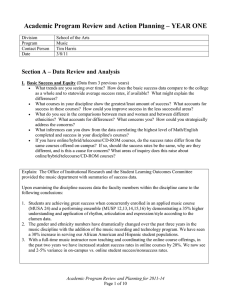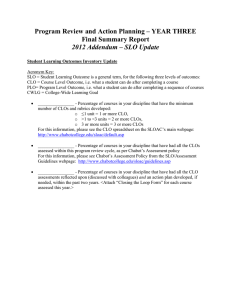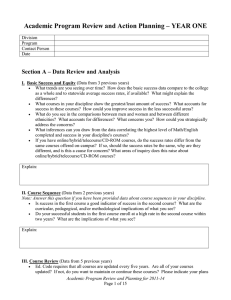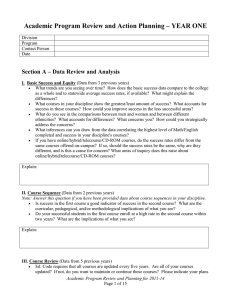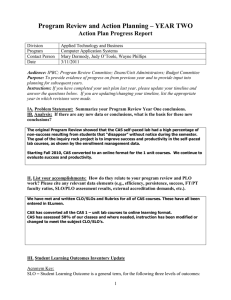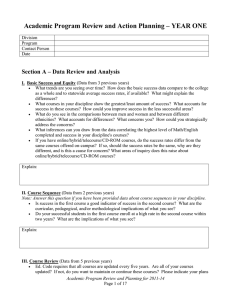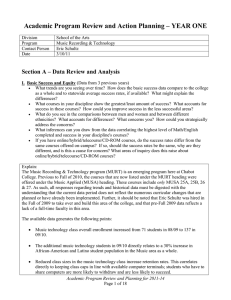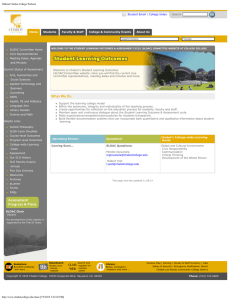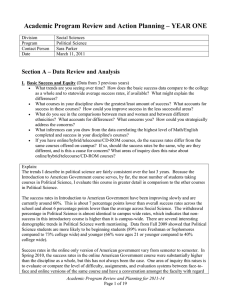Academic Program Review and Action Planning – YEAR ONE
advertisement
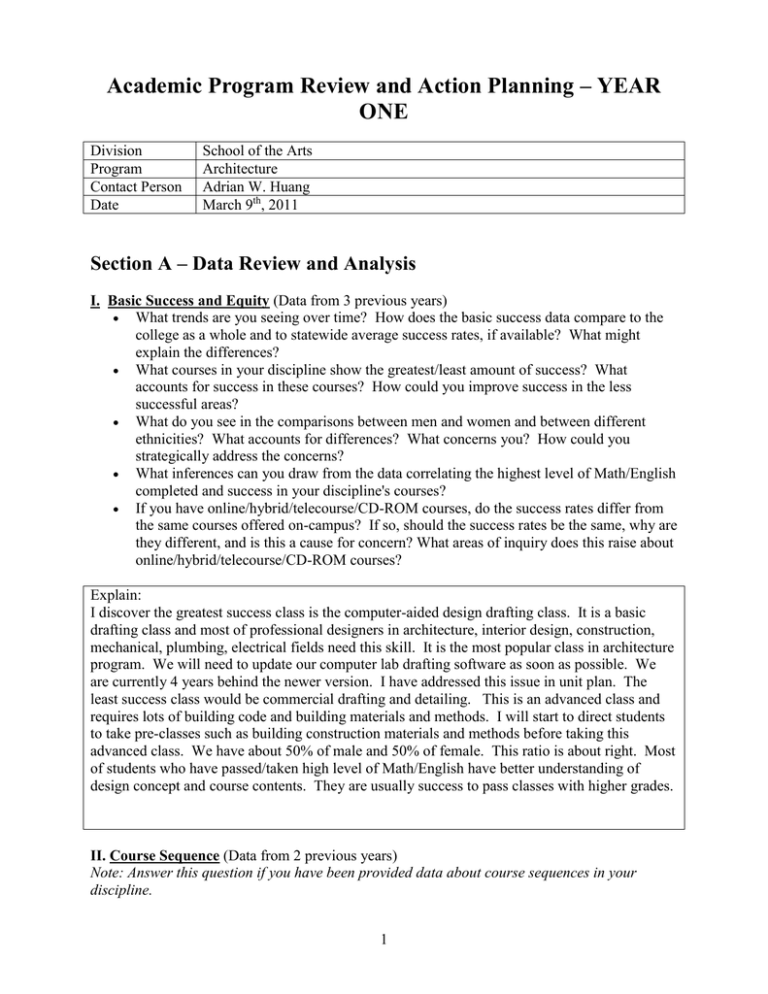
Academic Program Review and Action Planning – YEAR ONE Division Program Contact Person Date School of the Arts Architecture Adrian W. Huang March 9th, 2011 Section A – Data Review and Analysis I. Basic Success and Equity (Data from 3 previous years) What trends are you seeing over time? How does the basic success data compare to the college as a whole and to statewide average success rates, if available? What might explain the differences? What courses in your discipline show the greatest/least amount of success? What accounts for success in these courses? How could you improve success in the less successful areas? What do you see in the comparisons between men and women and between different ethnicities? What accounts for differences? What concerns you? How could you strategically address the concerns? What inferences can you draw from the data correlating the highest level of Math/English completed and success in your discipline's courses? If you have online/hybrid/telecourse/CD-ROM courses, do the success rates differ from the same courses offered on-campus? If so, should the success rates be the same, why are they different, and is this a cause for concern? What areas of inquiry does this raise about online/hybrid/telecourse/CD-ROM courses? Explain: I discover the greatest success class is the computer-aided design drafting class. It is a basic drafting class and most of professional designers in architecture, interior design, construction, mechanical, plumbing, electrical fields need this skill. It is the most popular class in architecture program. We will need to update our computer lab drafting software as soon as possible. We are currently 4 years behind the newer version. I have addressed this issue in unit plan. The least success class would be commercial drafting and detailing. This is an advanced class and requires lots of building code and building materials and methods. I will start to direct students to take pre-classes such as building construction materials and methods before taking this advanced class. We have about 50% of male and 50% of female. This ratio is about right. Most of students who have passed/taken high level of Math/English have better understanding of design concept and course contents. They are usually success to pass classes with higher grades. II. Course Sequence (Data from 2 previous years) Note: Answer this question if you have been provided data about course sequences in your discipline. 1 Is success in the first course a good indicator of success in the second course? What are the curricular, pedagogical, and/or methodological implications of what you see? Do your successful students in the first course enroll at a high rate in the second course within two years? What are the implications of what you see? Explain: Yes, student success in the first course is good indicator of success in the second course. Most of students show the interest in the program and spend more time on the class subjects. Yes, my successful students in the first course enroll at a high rate in the second course within two years. They are continuing to enroll in the program classes with confidence. III. Course Review (Data from 5 previous years) Ed. Code requires that all courses are updated every five years. Are all of your courses updated? If not, do you want to maintain or continue these courses? Please indicate your plans in terms of curriculum. Have all of your courses been offered recently? If not, why? Are students counting on courses to complete a program or major when these courses are not being offered? Explain: Yes, all my courses were updated in 2010. We are trying to offer all classes in our program but budget. Due to the budget recession, we cannot offer classes accordingly. Students are still taking classes that we offer and take classes that we don’t offer in some other colleges to continue their major and program. IV. Budget Summary (Data from 3 previous years) What budget trends do you see in your discipline? What are the implications of these trends? Where is your budget adequate and where is it lacking? What are the consequences on your program, your students, and/or your instruction? What projected long-term (5-10 years) budget needs do you see? You will detail your short-term needs in the action plan that follows. You do not need to cite them here. Explain: I do see the decreased budget in my discipline due to the Statewide budget shortage. This trend will implicate my student for their success in getting degree and delay their transfer plan. The budget should be adequate to offer every class in our discipline. We are alternating classes every other semester. Students need to wait for entire year to take particular class if they miss current term. For the long-term goal, we will need to increase FTEF budget up to 3.582 to be able to offer complete Architecture program. (We are currently having 1.882 FTEF). 2 V. Enrollment Data (Data from 2 previous years) Please provide a brief description of: overall enrollment trends; enrollment trends by course; and enrollment trends by time of day and Saturday. Describe what your discipline has done in terms of curriculum or scheduling in the last two years that has effected enrollments. Describe plans or strategies that you have for the near future in terms of curriculum or scheduling that could impact your enrollments. Lastly, look closely at whether the schedule you currently offer provides access to the broader community that your discipline serves at Chabot College—day time, night time, Saturday, distance education, special or targeted communities that would or do enroll in your courses. Explain: Overall, students who enroll in our program are transfer students. But more students are interested in computer-aided design drafting courses due to the industrial demands. These courses are Architectural Drafting and Design, Commercial Drafting and Detailing, 3D modeling and basic computer drafting. Since rearrange class schedules, more full time students enroll in day time classes instead of evening classes. Also by changing ARCH 33 title, Form-Z design to 3D modeling, the enrollment in this class has increased. Spring 2011, our building construction materials and methods (ARCH 12) has offered online. This class can register anywhere in State of California as well as United States. VI. Student Learning Outcomes Inventory Acronym Key: SLO = Student Learning Outcome is a general term, for the following three levels of outcomes: CLO = Course-level Outcome, i.e. what a student can do after completing a course PLO= Program-level Outcome, i.e. what a student can do after completing a sequence of courses CWLG = College-wide Learning Goal Percentage of courses in your discipline that have CLOs and rubrics developed:__100%_______ For this information, please see the list of which courses do and do not have CLOs on the SLOAC’s main webpage: http://www.chabotcollege.edu/sloac/default.asp Percentage of courses in your discipline that have the minimum number of CLOs developed: (1 unit = 1 or more CLO, 2 units = 2 or more CLOs, 3 or more units = 3 or more CLOs)__100%_____ For this information, please see the CLO spreadsheet on the SLOAC’s main webpage: http://www.chabotcollege.edu/sloac/default.asp Date the CLO Assessment schedule was submitted:_Fall 2010_______ 3 For this information, please see the Course-level Outcomes assessment schedules list from the Assessment Progress and Plans webpage: http://www.chabotcollege.edu/sloac/progress.asp Percentage of courses in your discipline that have had all the CLOs assessed within the past three years, as per Chabot’s Assessment policy: __95%_____ For this information, please see Chabot’s Assessment Policy from the SLO/Assessment Guidelines webpage: http://www.chabotcollege.edu/sloac/guidelines.asp Percentage of courses in your discipline that have had all the CLO assessments reflected upon, or discussed with colleagues, within the past three years____100%___ What questions or investigations arose as a result of these reflections or discussions? Explain: Need to offer more technical/vocational classes per A/E/C industrial need. What actions has your discipline determined that might be taken as a result of these reflections, discussions, and insights? Actions planned: Design and create technical/vocational courses such as internship, model making, computer generating models to suit Building Information Modeling (B.I.M) What course-level and programmatic strengths have the assessment reflections revealed? Strengths revealed: Percentage of programs within your discipline that have established at least two PLOs, and mapped appropriate CLOs to them:_100%_______ For this information, please see the Program-level Outcomes progress page from the Assessment Progress and Plans webpage: http://www.chabotcollege.edu/sloac/progress.asp Which of the CWLGs do your discipline’s CLOs address? Students learn architecture knowledge, develop technical & drafting skills. _________________________________________________________________________ _____ In which if any of the College-wide Learning Goals Faculty Inquiry Groups have discipline member(s) participated? _________________________________________________________ _________________________________________________________________________ _____ Insights gained: 4 VII. Academic Learning Support What kinds of academic learning support does your discipline use or require to help students succeed (e.g., tutoring, learning assistants, student assistants, peer advisors, lab support, supplemental instruction, peer-led team learning, peer advisors)? How many hours per semester do you use and/or how many hours per semester do you need? Explain: There are tutoring in our program. We have 4 hours per week available for students. We need four more hours for computer drafting lab. VIII. External Data Cite any relevant external data that affects your program (e.g., labor market data, community demand, employment growth, external accreditation demands, etc.). The labor market data, community demand and employment growth are affecting to our program. Since architecture is a vocational program, the enrollment slightly depends on these data. Section B – Data Summary From what you have learned in your basic data review, what does the information tell you about your program? Overall, what improvements would you like to make to your program? How do you plan to address these concerns? Are there any immediate issues that require immediate attention (e.g., outdated course outlines)? Where appropriate, please cite relevant data in your discussion (e.g., efficiency, persistence, success, FT/PT faculty ratios, SLO/PLO assessment results, external accreditation demands, etc.). Data Summary and Plan of Action Description/Rationale: Within our program, all classes accomplished SLO and CLO. This data has shown that architecture program is a fully developed program. The only concern I have would be the computer and drafting lab hours. To make this program better, that will need to form our studio and computer lab available to most of architecture students after class hours. Also the FT/PT faculty ratios need to be adjusted. To be able to serve architecture students, we will need 2 more PT faculty. Section C – Action Planning Please propose a two-year plan of action and timeline to address any immediate and/or long-term concern(s). This includes activities to assess the CLO(s) to discover a plan of action. It may also include specific activities that address improving CLO(s) and their assessment, that is to say evaluating the CLO(s) and the assessment activities. 5 Examples of activities include: Research and inquiry project – why is this happening? Innovation and Pilot Projects – this is something I want to try Intervention activities such as support services – this is what I want to do about it Program and curriculum modification – this is what I want to do about it 6 I. Action Plan Timeline: Detail the timeline for accomplishing your goals PLOs and/or Program Goal(s) Timeline Activity Support Needed to Accomplish These Activities* Outcome(s) Expected Person(s) Responsible Certificate of achievement a year In progress No 12/2011 Adrian W. Huang Start the Internship program a year In progress No 12/2011 Adrian W. Huang Update drafting software a year NO Yes ? Gary M. Carter Accomplished? Yes/No/In Progress YEAR ONE LEAVE BLANK Definitions of terms: Program Goal = A general statement of what the program hopes to accomplish, for the long-term. It may be in qualitative (narrative) rather than quantitative (numeric) terms. It may include the integration of several program outcomes, or relate to class scores, credits, units, course completion, retention term to term, progression to next course/level, program completion, degree and certificate completion, transfer, success/scores on licensure exams, job placement, attitudes, fundraising, media promotion, etc. PLO = Program-level Outcome, i.e., what students can do, what knowledge they have, after completing a sequence of courses. It is a subset of the Program Goals, related to student learning. *Types of Support Needed to Accomplish Activities: Training or workshops Publications, library, resources Guidance to support research and/or inquiry projects Technology 7 II. Strategic Plan Goals and Summaries: Which Strategic Plan goals and strategies does your action plan support? Awareness and Access Increase familiarity with Chabot Reach out to underrepresented populations Promote early awareness and college readiness to youth and families Multiple ways to deliver instruction and services for all Student Success Strengthen basic skills development Identify and provide a variety of career paths Increase success for all students in our diverse community Assess student learning outcomes to improve and expand instruction and services Community Partnership Increase experiential learning opportunities Initiate/expand partnerships among the college, businesses and community organizations Promote faculty and staff involvement in college and community activities Engage the community in campus programs and events Vision Leadership and Innovation Improve institutional effectiveness Streamline academic and student support services Professional development to support teaching, learning and operational needs Support effective communication both in the college and the community Provide safe, secure and up-to-date facilities and technology 8 9
